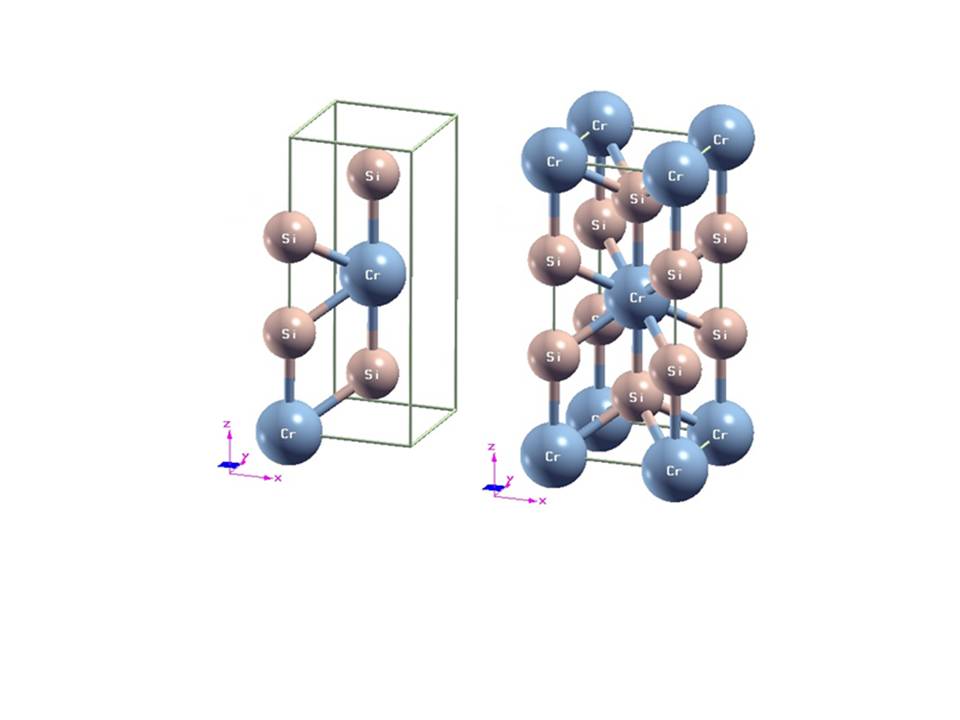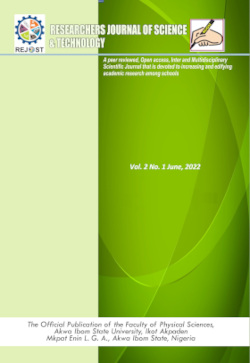Structural, Electronic, Thermophysical and Optical Investigation of Tetragonal (C11b - CrSi2) Material: A Theoretical Analysis
Keywords:
Chromium disilicide, Tetragonal C11b - CrSi2, Dielectric functions, DOS, Thermodynamic propertiesAbstract
Chromium disilicide (C11b - CrSi2) have garnered significant attention owing to the novel functions and considerable prospective it holds in ultrahigh temperature engineering applications. The tetragonal structure ( ) being one of the polymorphs of the is investigated in this paper for its thermophysical and optical dielectric properties, which are still lacking in reported studies. The present investigation aim to study the optical real and imaginary parts of dielectric function, joint density of state, the refractive index, and extinction coefficient using first-principle calculations based on density functional theory (DFT). This approach requires knowledge of the atomic species and crystal structure to predict several physical properties of materials. The values of the optimized lattice parameters are in good agreement with experimental results. The diagrams illustrating the electronic band structure and density of state (DOS) plots reveal the compound from the bonding and antibonding characters as a metal in accordance with the experiment. The calculated DOS of tetragonal is 3.61 per eV. In addition, while the equilibrium unit-cell volume, bulk modulus , and bond-lengths (Si–Si and Cr–Si) are in agreement with the available data, the first derivative of the bulk modulus and minimum energy are predicted for future studies. Furthermore, the thermophysical properties of the compound are analyzed at 300 K. The evaluated Debye temperature θ(D) (= 867.87 K) and the high value of (= 284.0 GPa) reflect the feasibility of the material being ductile, while the Debye heat capacity (142.13 J/mol·K) reveals the Dulong-Petit limit. Also, we predict a minimum thermal conductivity of 17.43 mW/K/m. Our study shows that the internal energy, the entropy, and the constant volume heat capacity increase with increasing temperature, while the free energy decreases monotonously with the increase in temperature. Consequently, predictive models for the thermodynamic quantities are herein presented. The calculated optical dielectric properties, such as imaginary and real parts of dielectric function, refractive index, and extinction coefficient, reveal relatively high anisotropy, with indications that the absorption spectrum predominantly depends on the electronic transitions from 3d-Cr and 3p-Si migrations around the Femi level.
References
Adachi, S., (2005). Properties of Group-IV, III–V and II–VI Semiconductors (New York: Wiley, 2005).
Adebambo, P.O., Bamgbose, K.M, Olowofela, J.A., Oguntuase, J.A., Adebayo, G.A., (2010). Electronic structure and optical properties of α –Fe–Al alloy from ab initio calculations. Physica B 405: 4578–4581. https://doi.org/10.1016/j.physb.2010.08.043
Adolph, B., Tenelsen, K., Gavrilenko, V.I., Bechstedt, F., (1997). Optical and loss spectra of SiC polytypes from ab initio calculations. Phys. Rev. B 55 (3): 1422. https://doi.org/10.1103/PhysRevB.55.1422
Anderson, O. L., (1963). A simplified method for calculating the Debye temperature from elastic constants. J. Phys. Chem. Solids, 24 (7), 909–917. https://doi.org/10.1016/0022-3697(63)90067-2
Bellani V., Guizzetti G., Marabelli F., Piaggi, A., Borghesi, A., Nava, F., Antonov, V. N., Antonov, Vl. N., Jepsen, O., Andersen, O. K.,
Nemoshkalenko, V. V., (1992). Theory and experiment on the optical properties of CrSi2. Phys. Rev. B, 46: 9380-9389. https://doi.org/10.1103/PhysRev-B.46.9380
Bioud, N., Kassali, K., Bouarissa, N., (2017). Thermodynamic Properties of Compressed CuX (X = Cl, Br) Compounds: Ab Initio Study, J. Electron Mater., 46, pp.2521. https://doi.org/10.1007/s11664-017-5335-x
Birch, F., (1978). Finite strain isotherm and velocities for single-crystal and polycrystalline NaCl at high pressures and 300°K. J. Geophys. Res.: Solid Earth, 83: 1257–1268. https://doi.org/10.1029/JB083IB03P01257
Cheng, C-H., Lien, Y-C., Wu, C-L., Lin, G-R., (2013). Multicolor electroluminescent Si quantum dots embedded in SiOX thin film MOSLED with 2.4% external quantum efficiency, Optics Express, 21(1), pp. 391 – 403. https://doi.org/10.1364/OE.21.000391
Clarke, D.R., (2003). Materials Selection Guidelines for Low Thermal Conductivity Thermal Barrier Coatings. Surf. Coat. Technol., 163–164, 67–74. https://doi.org/10.1016/S0257-8972(02)00593-5
Courtel, F. M., Duguay, D., Lebdeh, Y. A., Davidson, I. J., (2012). Investigation of CrSi2 and MoSi2 as anode materials for lithium-ion batteries. J. Power Sources, 202, 269–275. https://doi.org/10.1016/j.jpowsour.2011.11.047
Danilov F.I., Protsenko V.S., Gordiienko V.O., Kwon S.C., Lee J.Y., Kim M., (2011). Nanocrystalline hard chromium electrodeposition from trivalent chromium bath containing carbamide and formic acid: Structure, composition, electrochemical corrosion behavior, hardness and wear characteristics of deposits. Appl. Surf. Sci., 257: 8048–8053. https://doi.org/10.1016/-j.apsusc.2011.04.095
Ekong, S. A., Fuwape, I.A., Odo, E.A., (2014).Ab initio study of the electronic structure ofsilicon quantum dots. J. Nig. Assoc. Math.Phys., 26: 177 – 186.
Ekong, S.A., Oloye, M.T., Oyegoke, D.A., (2015). Ground-state energy calculation of helium atom using quantum Monte Carlo casino-code, Adv. Phys. Theo. Appl., 46: 1 - 6.
Ekong, S.A., Osiele, M. O., (2016). A Quantum Confinement Study of the Electronic Energy of Some Nanocrystalline Silicon Quantum-Dots, Intl. Lett. Chem. Phys. Astron., 63: 106 – 110. https://doi.org/10.18052-/www.scipress.com/ILCPA.63.106
Galkin, N. G., Velichko, T. A., Skripka, S. V., et al. (1996). Semiconducting and structural properties of CrSi2 A-type epitaxial films on Si (111). Thin Solid Films, 280: 211–220.
Ghoranneviss M., Sari A.H., Esmaeelpour M., (2004). Nitrogen implantation and heat treatment effect on the hardness improvement of the chromium film surface deposited on Si (1 1 1) substrate. Appl. Surf. Sci., 237: 326–331. https://doi.org/10.1016-/S0169-4332(04)00981-X
Giannozzi, P., Baroni, S., Bonini, N., Calandra, M., Car, R., Cavazzoni, C., Ceresoli D., Chiarotti, G. L., Cococcioni, M., Dabo, I.,et al. (2009). "QUANTUM ESPRESSO: a modular and open-source software project for quantum simulations of materials." Journal of physics: Condensed matter 21 (39): 395502. https://doi.org/10.1088-/0953-8984/21/39/395502
Gregory, E. E., Ekong, S. A., Emah, J. B., (2024). Ab-initio Assessment of the Electronic, Mechanical, Thermal, Optical and Phonon Properties ofB3-AlAs, Res. J. Sci. Technol., 4(3): 69 – 93.
Han, N., Liu, H., Zhao, J., (2015). Novel Magnetic Monolayers of Transition Metal Silicide. J. Supercond. Nov. Magn., 28(6), 1755–1758. https://doi.org/10.1007/-s10948-014-2940-2
He, J., Guo, X., Qiao, Y., (2020). Oxidation behavior and adhesion performance of TiSi2-NbSi2 composite coating prepared via magnetron sputtering and then pack cementation. J. Alloys Compd., 820, 153425. https://doi.org/10.1016/j.jallcom-.2019.153425
Jong, J.-Y., Zhu, J., Pak, S.-I., Sim, G.-H., (2016). Theoretical Investigation of Mechanical, Electronic, and Thermal Properties of Fe2TiSi and Fe2TiSn under Pressure. J. Electron. Mater. 45: 5104–5111. https://doi.org/10.1007/s11664-016-4722-z
Kondo, S-i., Hasaka, M., Morimura, T., Miyajima, Y., (1994). Mössbauer effect of Co- or Mn-doped β-FeSi2, Physica B, 198(4), 332–336. https://doi.org/10.1016-/0921-4526(94)90021-3
Krijn, M. P. C. M., Eppenga R., (1991). First-principles electronic structure and optical properties of CrSi2. Phys. Rev. B, 44: 9042-9044. https://doi.org/10.1103/PhysRev-B.44.9042
Lebga, N., Daoud, S., Sun, X-W, Bioud, N., Latreche, A.,(2018). Mechanical and Thermophysical Properties of Cubic Rock-Salt AlN under High Pressure,J. Electron. Mater. 47: 3430–3439. https://doi.org/-10.1007/s11664-018-6169-x
Lin Y.C., Hsu C.Y., Hung S.K., Chang C.H., Wen D.C., (2012). The structural and optoelectronic properties of Ti-doped ZnO thin films prepared by introducing a Cr buffer layer and post-annealing. Appl. Surf. Sci., 258: 9891–9895. https://doi.org/10.-1016/j.apsusc.2012.06.046
Lu, Y., Duan, Y., Peng, M., Yi, J., Li, C., (2021). First-principles calculations of electronic, optical, phononic and thermodynamic properties of C40-type TMSi2 (TM = Cr, Mo, W) disilicides. Vacuum, 191, 110324. https://doi.org/10.1016/j.-vacuum.2021.110324
Maier-Flaig, F., Rinck, J., Stephan, M., Bocksrocker, T., Bruns, M., Kübel, C., Powell, A. K., Ozin, G. A., Lemmer, U., (2013). Multicolor silicon light-emitting diodes (SiLEDs), ACS Nano-letters, 13 (2), pp. 475 – 480. https://doi.org/-10.1021/nl3038689
Malica, C., Corso, A.D., (2020). Quasi-harmonic temperature dependent elastic constants: applications to silicon, aluminum, and silver. J. Phys. Condens. Matt., 32. https://doi.org/10.1103/PhysRevB.-55.14422
Malica, C., Dal Corso, A., (2020). Temperature dependent elastic constants and thermodynamic properties of BAs: An ab initio investigation. J. Appl. Phys., 127, 245103-1 – 245103-6. https://doi.org/10.1063-/5.0011111
Mattheiss, L.F., (1992). Calculated structural properties of CrSi2, MoSi2, and WSi2. Phys. Rev. B: Condens. Matter Mater. Phys. 45(7), 3252–3259. https://doi.org/10.1103/physrevb.45.3252
Mesbah, S., Houari, M., Boufadi, F.Z., Bouadjemi, B., Lantri, T., Bentata, S., Ameri, M., (2021). Full Heusler alloys, with high absorption coefficient, insight into the optical properties of Li2CaC and Li2SrC, Sol. Stat. Comm., 328, 114238. https://doi.org/10.1016/j.ssc.2021.114238
Monkhorst, H.J., Pack, J.D., (1976). Special points for Brillouin-zone integrations, Phys. Rev. B, 13, pp.5188–5192. https://doi.org/10.1103/PhysRevB.13.5188
Mousa, A. M., Jawad, K. H., (2015). Performance of a Nano PbS/Si Hetrojunction deposited by chemical spray pyrolysis, Intl. Lett. Chem. Phys. Astron., 51: 13 – 16. https://doi.org/10.56431/p-4f9xb7
Murnaghan, F.D., (1944). The compressibility of media under extreme pressures, Proc.Natl. Acad. Sci. 30 (9). http://dx.doi.org/10.1073/pnas.30.9.244
Pan, Y., (2020a). Structural prediction and overall performances of 〖CrSi〗_2 disilicides: DFT Investigations. ACS Sustainable Chem. Eng., 8, 11024−11030. https://dx.doi.org/10.1021/acssuschemeng.0c04737
Pan, Y., (2020b). First-principles investigation of structural, electronic, and optical properties of transition metal-doped C40 CrSi2. Intl. J. Quantum Chem., e26401. https://doi.org/10.1002/qua.26401
Pan, Y., Li, Y., Zheng, Q., (2019). Influence of Ir concentration on the structure, elastic modulus and elastic anisotropy of Nb Ir based compounds from first-principles calculations. J. Alloys Compd., 789, 860−866. https://doi.org/10.1016/j.jallcom.2019.03.083
Pan, Y., Mao, P., Jiang, H., Wan, Y., Guan, W., (2017). Insight into the effect of Mo and Re on mechanical and thermodynamic properties of NbSi2 based silicide. Ceram. Intl., 43(6), 5274 – 5282. https://doi.org/10.1016/j.ceramint.2017.01.055
Santoni F., Giovine E., Torrioli G., Chiarello F., Castellano M.G., (2014). Study of the Fabrication Process for a Dual Mass Tuning Fork Gyro. Procedia Eng., 87: 991–994. https://doi.org/10.1016/j.proeng.2014-.11.325
Shin, Y., Rhim, S. H., Duong, A. T., Nguyen, V. Q., Hong, S. C., Cho, S., Park, H-M., (2015). New synthesis of MnSi2 thin film and its thermoelectric properties. J Vac. Sci. Technol. A 33(6), 061516. http://dx.doi.org/10.1116/1.4932515
ShiYun, Z., Quan, X., WanJun, Y., Qian, C., (2009). First-principles study on the electronic structure and optical properties of CrSi2. Sci. China Ser. G: Phys. Mech. Astron., vol. 52, no. 1, 46–51. https://doi.org/10.1007/s11433-009-0003-7
Vanderbilt, D., (1990). Soft self-consistent pseudopotentials in a generalized eigenvalue formalism, Phys. Rev. B, 41, pp. 7892(R). https://doi.org/10.1103/Phys-RevB.41.7892
Vasudévan, A.K., Petrovic, J.J. (1992). A comparative overview of molybdenum disilicide composites., Mater. Sci. Engr., A 155(1-2), 1–17. https://doi.org/10.1016-/0921-5093(92)90308-n
Wan, B., Xiao, F., Zhang, Y., Zhao, Y., Wu, L., Zhang, J., Gou, H.,, (2016). Theoretical study of structural characteristics, mechanical properties and electronic structure of metal (TM=V, Nb and Ta) silicides. J. Alloy. Compd., 681, 412 – 420. https://doi.org/10.1016/j.jallcom.2016.04.253
Wang X., Chen F., Liu H., Liang W., Yang Q., Si J., Hou X., (2009). Fabrication of micro-gratings on Au-Cr thin film by femtosecond laser interference with different pulse durations. Appl. Surf. Sci., 255: 8483–8487. https://doi.org/10.1016-/j.apsusc.2009.06.057
Xiong, H., Gan, L., Li, M., (2020). Improving the oxidation resistance of WSi2 by boron doping: A DFT study. Mater. Today Commun., 25, 101312. https://doi.org/-10.1016/j.mtcomm.2020.101312
Yakaboylu, G. A., Yumak, T., Sabolsky, K., Sabolsky, E. M., (2020). Effect of high temperature preoxidation treatment on the oxidation behavior of MoSi2- and WSi2-Al2O3 composites. J. Alloys Compd., 816, 152499. https://doi.org/10.1016/j.jallcom-.2019.152499
Yate A.L., Mart L., Esteve J., Lousa A., (2017). Ultra Low Nanowear in Novel Chromium/Amorphous Chromium Carbide. Appl. Surf. Sci., 420, 707–713.https://doi.org-/10.1016/j.apsusc.2017.05.203
Zhou, S.G., Tian, M.L, Xu, Y., Zhang, C., Cao, Y., (2022). First-principles study of the elastic, thermal and optical properties of α-PbO2 and β-PbO2.Indian J. Phys., 96, pp.3449–3460. https://doi.org/10.1007-/s12648-022-02305-3

Downloads
Published
How to Cite
Issue
Section
License
Copyright (c) 2024 Researchers Journal of Science and Technology

This work is licensed under a Creative Commons Attribution-NonCommercial-NoDerivatives 4.0 International License.




